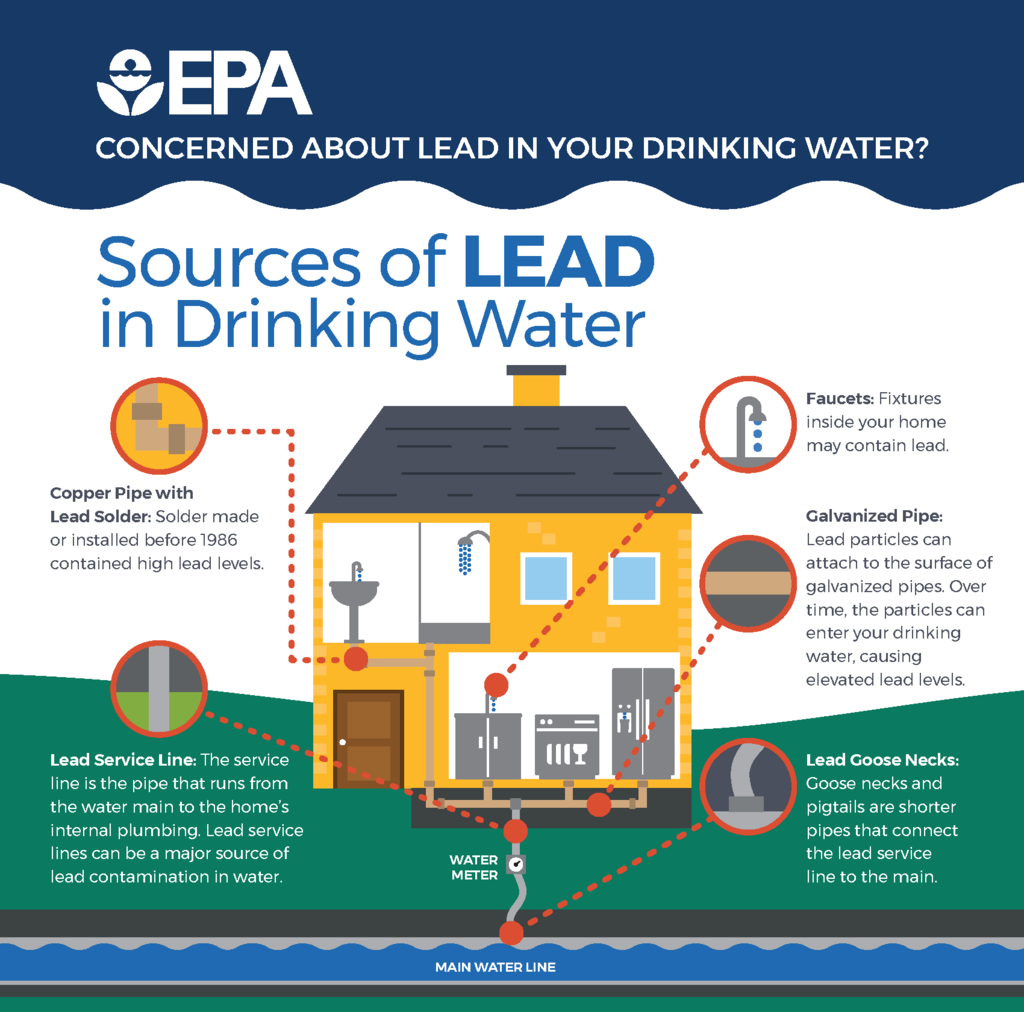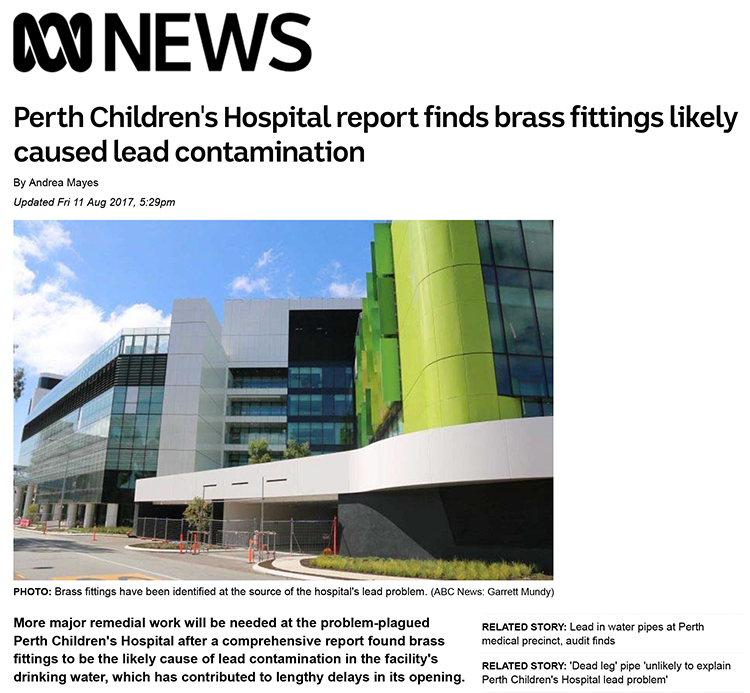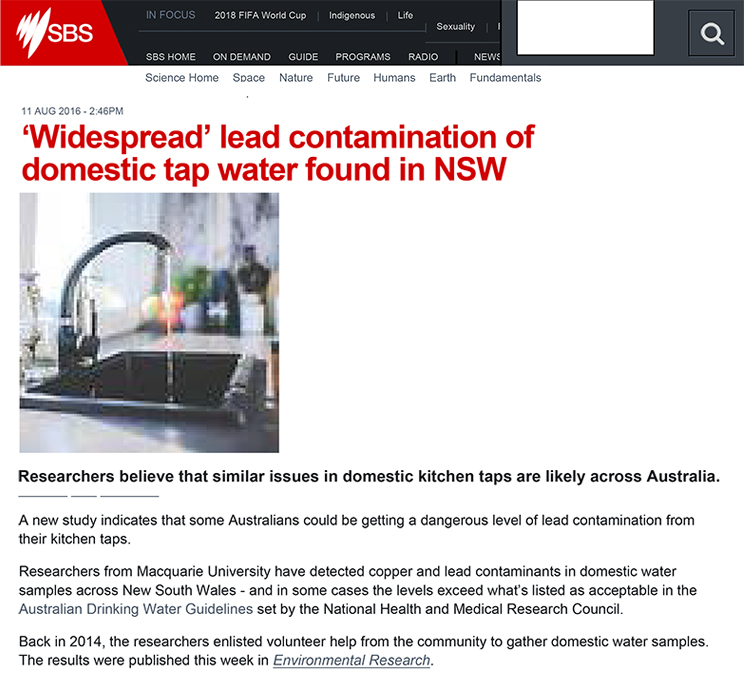Lead is a toxic metal which can impact on many organs of human body. Exposure to high levels of lead results in lead poisoning which causes severe damage to the brain, blood & kidneys.
Children under 6 are extremely vulnerable to lead poisoning. Even low levels of exposure had been shown to have permanent and long-term damages to children, especially on the brain and nervous system developments.
Lead is particularly harmful for pregnant mothers as well as her unborn baby. Centres for Disease Control and Prevention (CDC) stated there is an increased risk of miscarriage as well as premature and under-size babies. Furthermore, the baby’s brain, kidney and nervous system can all suffer which result in learning and behaviour problems.
Although unlike other drinking water contaminants, water does not generally contain lead. However, when corrosive water comes in contact with lead containing pipes or components, lead leaches out and contaminant drinking water.
Lead is a toxic metal which can impact on many organs of human body. Exposure to high levels of lead results in lead poisoning which causes severe damage to the brain, blood & kidneys.
Children under 6 are extremely vulnerable to lead poisoning. Even low levels of exposure had been shown to have permanent and long-term damages to children, especially on the brain and nervous system developments.
Lead is particularly harmful for pregnant mothers as well as her unborn baby. Centres for Disease Control and Prevention (CDC) stated there is an increased risk of miscarriage as well as premature and under-size babies. Furthermore, the baby’s brain, kidney and nervous system can all suffer which result in learning and behaviour problems.
Although unlike other drinking water contaminants, water does not generally contain lead. However, when corrosive water comes in contact with lead containing pipes or components, lead leaches out and contaminant drinking water.
Lead in drinking contaminated water
Old homes are likely to have lead containing water pipes as it had been a commonly used material for many years. Copper pipes which had been used till mid-1980s mostly include lead containing solders used on the joints. Lead goose necks and pigtails are commonly used in connecting distribution pipes into our home water lines.
In 2014 Flint, a city in Michigan, USA experienced one of the worst lead contamination in tap water. Tests by Virginia Tech noted nearly 40% of Flint homes have elevated lead levels while Environment Protection Authority (EPA) found dangerous levels of lead (nearly 7 times EPA limit) in the water at residents’ homes. One home had lead level nearly 50 times the EPA standard. Flint’s toxic lead contamination in its drinking water had been reported by Smithsonian.com to be due to corrosion of drinking water distribution pipes. Unfortunately, the report also indicates the problem is nationwide. USA today reported 4 million Americans could be drinking lead contaminated water without knowing the danger to their health.
Lead in drinking contaminated water
Old homes are likely to have lead containing water pipes as it had been a commonly used material for many years. Copper pipes which had been used till mid-1980s mostly include lead containing solders used on the joints. Lead goose necks and pigtails are commonly used in connecting distribution pipes into our home water lines.
In 2014 Flint, a city in Michigan, USA experienced one of the worst lead contamination in tap water. Tests by Virginia Tech noted nearly 40% of Flint homes have elevated lead levels while Environment Protection Authority (EPA) found dangerous levels of lead (nearly 7 times EPA limit) in the water at residents’ homes. One home had lead level nearly 50 times the EPA standard. Flint’s toxic lead contamination in its drinking water had been reported by Smithsonian.com to be due to corrosion of drinking water distribution pipes. Unfortunately, the report also indicates the problem is nationwide. USA today reported 4 million Americans could be drinking lead contaminated water without knowing the danger to their health.
Risk of lead contamination
Furthermore, one of the common and on-going risk of lead contamination in most building are plumbing fittings. Faucets, fixtures and fittings – even newly installed ones today may contain traceable amount of lead which can contaminant drinking water.
In 2016, researchers in Macquarie University in Sydney, Australia detected copper and lead contamination in domestic water samples across the state of NSW. They believed the cause of the lead contamination is right at homes, domestic tap/faucet which would be a widespread problem, not only in NSW, Australia but most likely a world-wide problem. Late 2017, it was reported a brand-new children hospital being built in Perth, Australia had brass fittings likely caused lead contamination in tap water. Plumbing fittings such as water tap and faucets containing lead which leach out into drinking water is a real current and ongoing problem.
Furthermore, one of the common and on-going risk of lead contamination in most building are plumbing fittings. Faucets, fixtures and fittings – even newly installed ones today may contain traceable amount of lead which can contaminant drinking water.
Risk of lead contamination
Furthermore, one of the common and on-going risk of lead contamination in most building are plumbing fittings. Faucets, fixtures and fittings – even newly installed ones today may contain traceable amount of lead which can contaminant drinking water.
In 2016, researchers in Macquarie University in Sydney, Australia detected copper and lead contamination in domestic water samples across the state of NSW. They believed the cause of the lead contamination is right at homes, domestic tap/faucet which would be a widespread problem, not only in NSW, Australia but most likely a world-wide problem. Late 2017, it was reported a brand-new children hospital being built in Perth, Australia had brass fittings likely caused lead contamination in tap water. Plumbing fittings such as water tap and faucets containing lead which leach out into drinking water is a real current and ongoing problem.
Furthermore, one of the common and on-going risk of lead contamination in most building are plumbing fittings. Faucets, fixtures and fittings – even newly installed ones today may contain traceable amount of lead which can contaminant drinking water.
Fittings likely caused lead contamination
In 2016, researchers in Macquarie University in Sydney, Australia detected copper and lead contamination in domestic water samples across the state of NSW. They believed the cause of the lead contamination is right at homes, domestic tap/faucet which would be a widespread problem, not only in NSW, Australia but most likely a world-wide problem.
Late 2017, it was reported a brand-new children hospital being built in Perth, Australia had brass fittings likely caused lead contamination in tap water. Plumbing fittings such as water tap and faucets containing lead which leach out into drinking water is a real current and ongoing problem.
Lead contamination in drinking water is a serious worldwide problem. Unfortunately, due to the numerous possible contamination sources – from water distribution pipes, soldering joints and faucets etc., lead will continue to leach into our tap water regardless of works by government or water suppliers.
Fittings likely caused lead contamination
In 2016, researchers in Macquarie University in Sydney, Australia detected copper and lead contamination in domestic water samples across the state of NSW. They believed the cause of the lead contamination is right at homes, domestic tap/faucet which would be a widespread problem, not only in NSW, Australia but most likely a world-wide problem.
Late 2017, it was reported a brand-new children hospital being built in Perth, Australia had brass fittings likely caused lead contamination in tap water. Plumbing fittings such as water tap and faucets containing lead which leach out into drinking water is a real current and ongoing problem.
Lead contamination in drinking water is a serious worldwide problem. Unfortunately, due to the numerous possible contamination sources – from water distribution pipes, soldering joints and faucets etc., lead will continue to leach into our tap water regardless of works by government or water suppliers.
As Dew using certified high grade activated carbon
Yet, lead can be easily and completely removed from tap water with an efficient water filtration system inside our homes.
As Dew Water Filtration System is an efficient, convenient and affordable way to have lead free water. Utilising unique patented technology by embedding high quality NSF certified high grade activated carbon in layers can effectively adsorbs lead, mercury, as well as other heavy metals, chemicals and contaminants found in tap water.
WHO information tract stated, “there is no safe level of lead exposure”. We all should drink lead free water. Lead should not be part of us.
As Dew using certified high grade activated carbon
Yet, lead can be easily and completely removed from tap water with an efficient water filtration system inside our homes.
As Dew Water Filtration System is an efficient, convenient and affordable way to have lead free water. Utilising unique patented technology by embedding high quality NSF certified high grade activated carbon in layers can effectively adsorbs lead, mercury, as well as other heavy metals, chemicals and contaminants found in tap water.
WHO information tract stated, “there is no safe level of lead exposure”. We all should drink lead free water. Lead should not be part of us.







